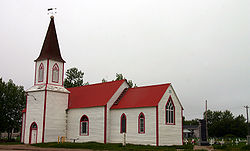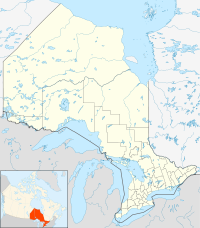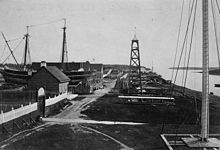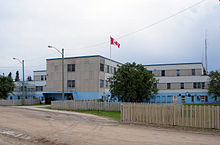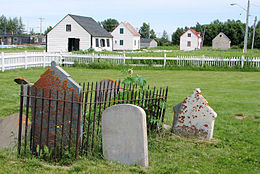- Moose Factory, Ontario
-
Moose Factory St. Thomas' Anglican Church Coordinates: 51°15′30″N 80°36′00″W / 51.25833°N 80.6°WCoordinates: 51°15′30″N 80°36′00″W / 51.25833°N 80.6°W Country  Canada
CanadaProvince  Ontario
OntarioRegion Northeastern Ontario District Cochrane Settled 1673 Renamed 1686 Government - Type multiple governments Area[1] - Land 5.25 km2 (2 sq mi) Elevation 7 m (23 ft) Population (2006)[1] - Total 2,458 - Density 473.3/km2 (1,225.8/sq mi) Time zone EST (UTC−5) - Summer (DST) EDT (UTC−4) Postal code P0L 1W0 Area code(s) 705 Moose Factory is a community in the Cochrane District, Ontario, Canada. It is on Moose Factory Island, near the mouth of the Moose River, which is at the southern end of James Bay. It was the first English-speaking settlement in Ontario and the second Hudson's Bay Company post to be set up in North America after Fort Rupert. Across the Moose River is the nearby community of Moosonee, which is accessible by water taxi in the summer and ice road in the winter.
The island and town are mainly inhabited by indigenous Cree people, but are politically divided into two entities:[1]
- Factory Island 1 (population: 1451) - Indian reserve of 3.08 square kilometres (1.19 sq mi)[2] that make up the northern two-thirds of the island, belonging to the Moose Cree First Nation and is governed by an elected Chief, Deputy Chief, and Councilors. In 2005, Patricia Faries-Akiwenzie, a practicing lawyer from Moose Factory, became the first woman to be elected as Chief.
- Unorganized Cochrane District (population: 1007) - Unincorporated southern third of the island, home to the old Hudson's Bay Company post and government services, governed by the provincial Local Services Board and the federal Weeneebayko Health Ahtuskaywin that administers the regional medical facility, Weeneebayko General Hospital.
"Factory" refers to the archaic term for the trading posts system used by European colonial powers.
Contents
History
The area was explored by Pierre-Esprit Radisson in the winter of 1670/71 from the base at Rupert House. In 1673, Charles Bayly of the Hudson's Bay Company established a fur-trading post originally called Moose Fort. Besides trading, it was also intended to protect the company's interests from French traders to the south. The fort was profitable and had a direct impact on the fur trade in New France. So in 1686, Chevalier de Troyes led a small contingent of French soldiers north on an expedition to raid HBC forts. The English defenders were caught by total surprise and surrendered. The French captured Moose Fort and renamed it to Fort St. Louis. Ten years later in 1696, the English recaptured it and burned it to the ground. No trace has remained of this original fort.[3]
The Hudson's Bay Company set up a new fort in 1730, one mile upstream from the old site, to accommodate Cree traders for whom travel to the other James Bay posts was too dangerous. Five years later, this one also was destroyed by a fire that started in the kitchen, but was rebuilt over a period of seven years.[3]
In 1821, when the Hudson's Bay Company merged with the rival North West Company, there were no longer any serious threats and the post expanded beyond the fort's palisades. Thereafter it came to be known as Moose Factory. It became HBC's main base on James Bay, being the administrative headquarters of the Southern Department. The Governor of Rupert's Land and Council met frequently there to plan for the coming year's operations.[3][4]
In 1905, the Cree signed a treaty (Treaty 9) with the government that established the Factory Island Indian Reserve.[1] Around the same time, the Parisian furrier company Revillon Frères set up a trading post on the west bank of the Moose River. This post, first known as Moose River Post, grew into the town of Moosonee and provided stiff competition to the HBC Moose Factory post.[5] In 1931, the Temiskaming and Northern Ontario Railway was completed at Moosonee. This allowed supplies to be delivered from the south by train, thereby making sea voyages redundant that could only be done once per year. In 1936, the last supply ship arrived.[3]
After World War II, the Hudson's Bay Company transformed into a retail business, and in 1960, it opened a modern retail store in Moose Factory. The HBC staff house and other historic properties were converted into the open-air museum of Centennial Park that opened in 1967. The HBC continued to operate in Moose Factory until 1987, when its operations in northern Canada, including Moose Factory, were sold to The North West Company.[3] Today, the North West Company operates a grocery and general goods store at the Moose Cree Complex and a furniture, outdoor vehicles, fast food outlet and convenience store near some of the historic HBC buildings.
Economy
The economy of the island is based on the service sector, tourism, and construction. The largest employer is the Weeneebayko General Hospital, followed by Moose Cree First Nation and Northern Stores.[1]
Traditional subsistence lifestyles are no longer practiced by the Cree population but the majority of people still practice the traditional spring and fall goose hunt. Still practiced are the preparation and tanning of moose hides, the making of moccasins, moose hide mitts, beading, tamarack geese and snowshoes, with the handicrafts being sold locally.[1]
Education
Moose Factory has three schools:
- Ministik Public School is a public elementary school operated by the Moose Factory Island District School Area Board
- Delores D. Echum Composite School is a senior elementary and secondary school operated by the Moose Cree Education Authority
- Christian Academy is a private school
Some post-secondary programs are provided by Northern College.
Attractions and tourism
Notable attractions in Moose Factory include:[3]
- St. Thomas' Anglican Church - a historic Carpenter Gothic style Anglican church, completed in 1885
- Centennial Park:
- Hudson's Bay Company staff house - originally the "officers' dwelling" for HBC doctors, captains, clerks, and secretaries, it is now used as a museum and tourism office. The staff house was built between 1847 and 1850, making it the oldest building in the James Bay area and the last surviving HBC officers' dwelling.
- Hudson's Bay Company cemetery - Oldest tombstone is from 1802, marking the grave of the Cree wife and children of John Thomas who was the post's factor at that time. There are only a few graves of British men, since they would return home upon retirement or completion of their contract.
- Joseph Turner House - oldest known surviving servant house of the HBC, built in 1863.
- William McLeod House - carpenter's house built in 1889.
- Ham Sackabuckiskum House - the only surviving Cree summer home and one of the first balloon-frame construction house in Moose Factory, built in 1926 by the HBC as an incentive to ensure loyalty from Cree trappers.
- Blacksmith shop - last known surviving HBC blacksmith shop, built in 1849 and was used until 1934.
- Powder magazine - the only stone structure, built in 1865, was part of the palisaded warehouse complex. In the early 20th century, it was converted from gunpowder to general storage.
- Cree Cultural Interpretive Centre - an interpretive centre that displays many aspects of Cree culture and crafts.
- Cree Village Eco-lodge - an eco-tourist lodge and restaurant.
Outdoor tourism in summer and winter, such as trap-line tours, canoe expeditions, and snowmobile trips, are locally provided. The Tidewater Provincial Park is nearby on the adjacent island facing Moosonee.
The 19th century buildings associated with the Hudson's Bay Company post were designated a National Historic Site of Canada in 1957.[6][7]
Notable natives and residents
- NHL Ice hockey player Jonathan Cheechoo is a native of Moose Factory.
See also
- William Bevan (sloopmaster) - chief factor and commander of Moose Fort in 1732.
References
- ^ a b c d e f Wakenagun Community Futures Development Corporation - Moose Factory Community Profile
- ^ "Factory Island 1 community profile". 2006 Census data. Statistics Canada. http://www12.statcan.gc.ca/census-recensement/2006/dp-pd/prof/92-591/details/page.cfm?Lang=E&Geo1=CSD&Code1=3556094&Geo2=PR&Code2=35&Data=Count&SearchText=factory&SearchType=Begins&SearchPR=01&B1=All&Custom=. Retrieved 2010-12-21.
- ^ a b c d e f Moose Factory - An Exploration of Frontier History, Ontario Heritage Foundation, 2002, 07-02-12M-9002-2002
- ^ Hudson's Bay Company - Our History: Forts & Posts - The Staff House at Moose Factory
- ^ Revillon Frères, The Moosonee Development Area Board, 2002
- ^ Moose Factory Buildings, Directory of Designations of National Historic Significance of Canada
- ^ Moose Factory Buildings. Canadian Register of Historic Places.
External links
- Moose Cree First Nation - official website
- Hudson's Bay Company Post at Moose Factory
- Moose Cree Education Authority
- MoCreebec
- http://www.creevillage.com
City 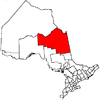
Towns Townships First Nations reserves Abitibi 70 • Constance Lake 92 • Factory Island 1 • Flying Post 73 • Fort Albany 67 • Moose Factory 68 • New Post 69 • New Post 69AUnorganized territories See also: Communities in Cochrane District • Census divisions of Ontario Categories:- Populated coastal places in Canada
- Communities in Cochrane District, Ontario
- Cree reserves in Ontario
- Local services boards in Ontario
- French forts in Canada
- Hudson's Bay Company forts
- Hudson's Bay Company trading posts
Wikimedia Foundation. 2010.

